Hemoglobin
Definition: Hemoglobin is the oxygen-carrying pigment and the predominant protein in the red blood cells that is responsible for delivery of oxygen to the tissues. Each hemoglobin molecule is made up of four subunits (globins) each containing a heme group. Heme contains iron, which gives a red color to the molecule. Hemoglobin forms an unstable, reversible bond with oxygen. In its oxygenated state it is called oxyhemoglobin (O2Hb) and is bright red. In its reduced state it is called deoxyhemoglobin (HHb) and is purple-blue. O2Hb and HHb have different magnetic and optical properties that give rise to functional magnetic resonance imaging (fMRI) and functional near-infrared spectroscopy (fNIRS) signals. O2Hb is diamagnetic (i.e. it shows a weak repulsion in magnetic fields) and has an optical absorption around 660nm. In contrast, HHb is paramagnetic (i.e. it shows a weak attraction in magnetic fields) and has an optical absorption around 760 nm. Hemoglobin concentrations in the blood depend on physiological processes and are thus affected in certain diseases (e.g. malnourishment) that can result in anemia.
Alternative definition:
Synonym:
References: F.G. Ashby. Statistical Analysis of FMRI Data. EBSCO ebook academic collection. MIT Press, 2011.Billett HH. Hemoglobin and Hematocrit. In: Walker HK, Hall WD, Hurst JW, editors. Clinical Methods: The History, Physical, and Laboratory Examinations. 3rd edition. Boston: Butterworths; 1990. https://www.ncbi.nlm.nih.gov/books/NBK259/
https://doi.org/10.1038/npjparkd.2016.21
Related terms: Oxyhemoglobin, Deoxyhemoglobin, Total Hemoglobin, Anaemia
